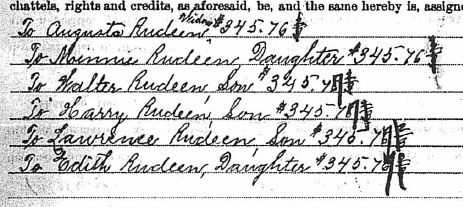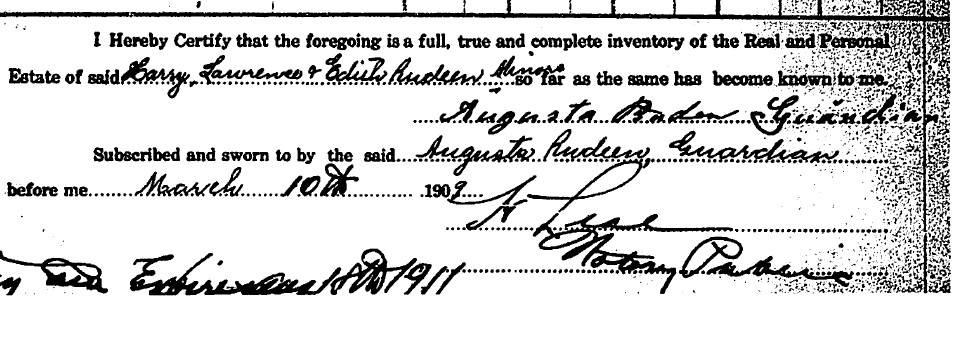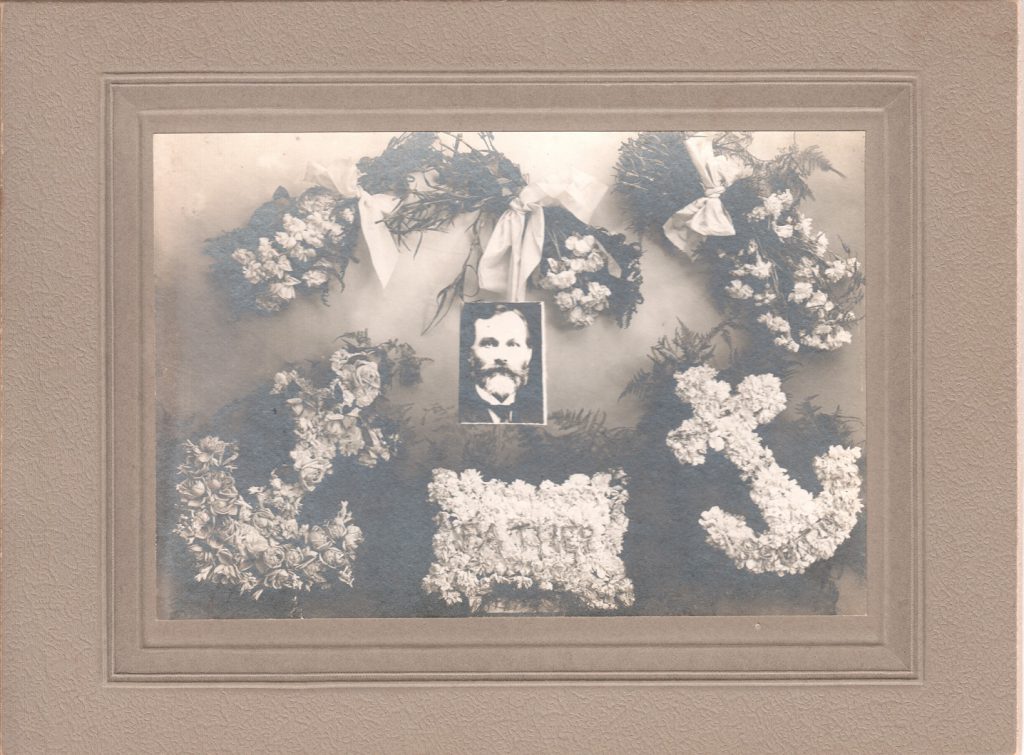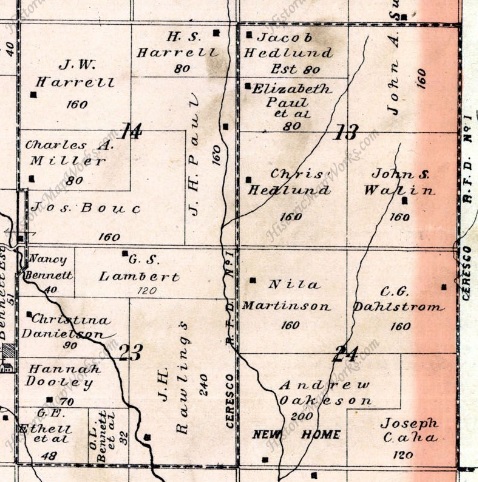In the first installment about Gust’s probate papers, we saw that he had assets totaling about $2800 at the time of his death. He did not own any real estate, but he had a nice little farming operation, some money in the bank, and a promissory note against his cousin Augusta Samuelson and her son Frank.
His brother-in-law Carl Oscar Anderson oversaw Gust’s estate for the next year following his death. It would have been Carl Oscar’s job to keep track of Gust’s assets, make sure bills were paid and that his heirs received their proportionate shares of the estate in the end.
The probate file contains some of the bills that had to be paid out. They included:
- $85 to Edward F. Biggerstaff for funeral expenses. Another $7 was spent for “18 cabinet photos of Rudeen flowers.” These types of photos were a Victorian-era tradition. A commemorative photo of the funeral flowers was given to friends and family. Shown below is Gust’s memorial photo; the portrait in the center was from the family portrait taken a few years earlier, apparently the only photo ever taken of him.
- Medical bills were paid to a doctor and to a druggist, probably for Gust’s treatment before he died.
- A payment of $11.50 was made to the Swedish Mission church. The estate was invoiced for this. It seems to have been the practice of these little churches to ask members to pledge their tithe for the year and then send out invoices quarterly. This probably gave the church some certainty in hiring a pastor and paying his salary.
- Farm operations continued after Gust’s death. Bills were paid to a blacksmith and to implement dealers. They purchased wheat seed, corn and oats for livestock feed, and supplies for butter and chickens. Clearly the family intended to keep things going in Gust’s absence.
- Oldest son Walter was reimbursed $37.25 for his payment to J.H. Rawlings for “hay land for 1907” – sounds like they rented some land for a hay crop. Looking at the 1907 Saunders County atlas, we see the Rawlings farm (Section 23) right across the road from the Nilla Martinson farm (Section 24) – lending credence to the idea that the Rudeen family was renting from Nilla.
- They also paid a Mr. Harrell for shelling some corn. The 1907 atlas shows a couple of Harrell farms just a mile north in Section 14.
- They invested $10 in a boar – this would be an adult male domestic pig, probably to be used for breeding purposes.
- Property tax bills came due – $1.50 still owing on 1906 taxes and $12.00 due for 1907.
- Various court costs and attorneys bills had to be paid, coming to almost $50 during the period that Carl Oscar was in charge.
- Carl Oscar also saw to it that Gust’s widow, Augusta, received a periodic “widow’s allowance” so that she would have some disposable income while the estate was in probate.
All told, Car Oscar supervised the payment of $1,197.02 in bills during the year that he supervised the family’s affairs.
He also oversaw the preparation of a more detailed accounting of the family’s assets and itemized their cash receipts for the year. In addition to what he had previously itemized shortly after Gust’s death, he noted the following additional assets and receipts:
- 40 hogs remained on the farm after the sale of a portion of the herd for $395.77. Only 32 hogs were listed in the first inventory, so clearly that boar had gotten busy!
- They also sold chickens, butter and the bull. The bull fetched $31 but they made almost $40 selling butter.
- The seven horses were more specifically identified as three separate teams worth $275, $200 and $50 respectively plus a “gray horse” worth $125.
- The $300 promissory note against Mrs. Augusta Samuelson was still outstanding with now $15 in interest due
The total value of all his assets were $3,271.62. Subtracting the $1,199.02 that had been paid out in expenses, the net value of his estate was $2,074.60.
Since he had died without a will, the statutes required that his assets be divided equally among his wife and children. The net value divided by six is $345.76, so the judge signed off on the final decree on February 18, 1908 with the following instructions for distribution to the heirs:

The oldest children, Minnie and Walter, were adults but the other three were still minors. Augusta had to sign on their behalf for their share of the estate:

Look at her cute Swedish-y signature!
I don’t think any of the kids received cash distributions. I think they kept the assets whole and the family continued their farming operations with all the shares pooled together.
Walter did not marry for another five years, so he probably stepped into his role as head of the family. The 1910 census shows the family still living all together in the Rock Creek Precinct.
This was my first look at an old probate file, I had no idea it would be so interesting!



